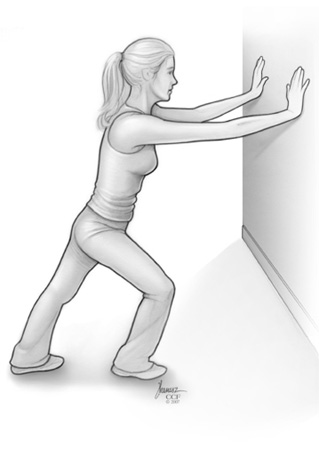Resumo
Definição
História e exame físico
Principais fatores diagnósticos
- presença de fatores de risco
- dor no calcanhar (aguda ou do tipo fisgada)
- dor aliviada com repouso
- discinesia pós-estática
- dor exacerbada à posição ortostática e em outras atividades da vida diária
Outros fatores diagnósticos
- dor exacerbada ao andar descalço ou com calçados sem suporte
- dor melhorou com o uso de um anti-inflamatório não esteroidal (AINE)
- ausência de história de lesão aguda no calcanhar
- dor autolimitada
- dor calcânea unilateral
- teste de dorsiflexão-eversão positivo
- teste do efeito molinete positivo
- sinal de Tinel negativo
Fatores de risco
- Índice de massa corporal (IMC) elevado
- equino
- pés planos
- pés cavos
- idade >40 anos
- histórico de posição ortostática ou caminhar por tempos prolongados
- atletas, principalmente corredores
- estilo de vida sedentário
- usar sapatos impróprios ou excessivamente gastos
- aumentos ou mudanças na atividade física
Investigações diagnósticas
Primeiras investigações a serem solicitadas
- radiografia do pé
Investigações a serem consideradas
- cintilografia óssea com tecnécio (Tc-MDP [metilenodifosfonato] em 3 fases)
- RNM
- HLA (antígeno leucocitário) B27
- fator reumatoide
- ultrassonografia
Algoritmo de tratamento
todos os pacientes
Colaboradores
Autores
Martha Anderson, DPM, FACFAS

Podiatric Foot and Ankle Surgeon
Private Practice
Foot and Ankle Wellness Center
Podiatric Foot and Ankle Surgeon
Department of Surgery
Grady Memorial Hospital
Delaware
OH
Declarações
MA declares that she has no competing interests.
Agradecimentos
Dr Martha Anderson would like to gratefully acknowledge Dr Georgeanne Botek, the previous contributor to this topic. GB declares that she has no competing interests.
Revisores
Mark A. Hardy, DPM, FACFAS
Director
Foot and Ankle Trauma Service
Kaiser Permanente
Cleveland
OH
Declarações
MAH declares that he has no competing interests.
Molly Judge, DPM, FACFAS
Board Certified in Reconstructive Rear foot and Ankle Surgery
Department of Surgery
St. Vincent Charity Hospital
Cleveland
OH
Declarações
MJ declares that she has no competing interests.
Patrick J. McKee, DPM
Program Director
Podiatric Residency
Cleveland Clinic
Cleveland
OH
Declarações
PJM declares that he has no competing interests.
Créditos aos pareceristas
Os tópicos do BMJ Best Practice são constantemente atualizados, seguindo os desenvolvimentos das evidências e das diretrizes. Os pareceristas aqui listados revisaram o conteúdo pelo menos uma vez durante a história do tópico.
Declarações
As afiliações e declarações dos pareceristas referem--se ao momento da revisão.
Referências
Principais artigos
Schneider HP, Baca JM, Carpenter BB, et al. American College of Foot and Ankle Surgeons clinical consensus statement: diagnosis and treatment of adult acquired infracalcaneal heel pain. J Foot Ankle Surg. 2018 Mar-Apr;57(2):370-81.Texto completo Resumo
Rhim HC, Kwon J, Park J, et al. A systematic review of systematic reviews on the epidemiology, evaluation, and treatment of plantar fasciitis. Life (Basel). 2021 Nov 24;11(12).Texto completo Resumo
Koc TA Jr, Bise CG, Neville C, et al. Heel pain - plantar fasciitis: revision 2023. J Orthop Sports Phys Ther. 2023 Dec;53(12):CPG1-39.Texto completo Resumo
American College of Radiology. ACR appropriateness criteria: chronic foot pain. 2020 [internet publication].Texto completo
Artigos de referência
Uma lista completa das fontes referenciadas neste tópico está disponível para os usuários com acesso total ao BMJ Best Practice.

Diagnósticos diferenciais
- Ruptura da fáscia plantar
- Síndrome do coxim gorduroso do calcanhar (atrofia do coxim adiposo)
- Fibromatose plantar proximal (doença de Ledderhose)
Mais Diagnósticos diferenciaisDiretrizes
- Heel pain - plantar fasciitis: revision 2023
- ACR appropriateness criteria: chronic foot pain
Mais DiretrizesFolhetos informativos para os pacientes
Obesidade - medicamentos e cirurgia
Obesidade - dieta e exercício
Mais Folhetos informativos para os pacientesConectar-se ou assinar para acessar todo o BMJ Best Practice
O uso deste conteúdo está sujeito ao nosso aviso legal